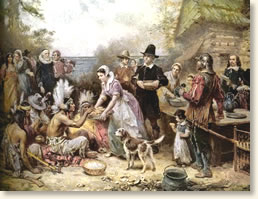|
The First Thanksgiving, 1621
It was not what they had planned. In September of 1620, 102 pilgrims embarked from England aboard the Mayflower (see Aboard the Mayflower, 1620). Their intent was to establish a settlement in the Hudson River area in the northern reaches of the recently established Virginia Colony. However, after a sixty-six-day journey they made landfall some 150 miles north of their target (whether by design or mishap is unclear) at the eastern tip of Cape Cod in present-day Massachusetts. They explored the area for about a month and then sailed further west to the mainland at present-day Plymouth. It was here that they decided to establish a new homeland.
 |
The First Thanksgiving
Jean Louis Gerome Ferris
1863-1930 |
For the first few months the majority of the expedition remained cloistered aboard ship where many succumbed to mal-nutrition and disease. It is estimated that half of their number died by the following Spring. With the return of favorable weather the remaining adventurers abandoned their ship and moved ashore to establish a settlement in the wilderness. They were aided by two members of the local Native American tribes. To the astonishment of the Pilgrims, both of these Good Samaritans spoke English. One, Squanto, a member of the Pawtuxet tribe, had been kidnapped by English adventurers a few years earlier and taken to England. He was subsequently able to achieve his release and return to his homeland
The Pilgrims' first corn harvest was successful and in November the group's leader, Governor William Bradford, called for a feast to celebrate their good fortune. Hunters were sent into the wilderness to hunt game for the event. Members of the local Native American tribes were invited and brought deer meat to add to the menu. The celebration lasted for three days
Edward Winslow was among the group of Pilgrims present at the first Thanksgiving. He describes the scene:
"Our harvest being gotten in, our governor sent four men on fowling, that so we might after a special manner rejoice together after we had gathered the fruit of our labors. They four in one day killed as much fowl as, with a little help beside, served the company almost a week.
At which time, amongst other recreations, we exercised our arms, and many of the Indians coming amongst us, and among the rest their greatest king Massasoit, with some ninety men, whom for three days we entertained and feasted, and they went out and killed five deer, which they brought to the plantation and bestowed on our governor, and upon the captain and others. And although it be not always so plentiful as it was at this time with us, yet by the goodness of God, we are so far from want that we often wish you partakers of our plenty."
References:
Edward Winslow's account appears in: Heath, Dwight, A Journal of the Pilgrims at Plymouth: Mourt's Relation (1963); EyeWitness to America (1997); Morrison, Samuel Eliot, Builders of the Bay Colony (1930).
How To Cite This Article:
"The First Thanksgiving, 1621," EyeWitness to History, www.eyewitnesstohistory.com (2010).
|






